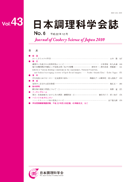All issues

Volume 43 (2010)
- Issue 6 Pages 327-
- Issue 5 Pages 281-
- Issue 4 Pages 221-
- Issue 3 Pages 151-
- Issue 2 Pages 57-
- Issue 1 Pages 1-
Predecessor
Volume 43, Issue 5
Displaying 1-9 of 9 articles from this issue
- |<
- <
- 1
- >
- >|
Review
-
Mayu Saito2010Volume 43Issue 5 Pages 281-285
Published: 2010
Released on J-STAGE: October 03, 2014
JOURNAL FREE ACCESSDownload PDF (1535K)
Original paper
-
Investigation of the Use of Superheated Steam with a Household Oven during the Baking of Sponge CakeKyoko Ohishi, Shoko Shibukawa2010Volume 43Issue 5 Pages 286-293
Published: 2010
Released on J-STAGE: October 03, 2014
JOURNAL FREE ACCESSBy using the household superheated steam ovens, we investigated the effect of the steam injection on the qualities of sponge cakes.
The cakes were cooked with the automated baking program that injected steam during the final stage of baking for a short time. These samples had slightly harder and more brittle textures than the cakes without steam. Next, the cakes were baked with continuous steam by using a test model oven. They had a mound shape, a darker color, and harder outside and softer inside than the cakes baked automatically and without steam. In addition, the cooking period was reduced by half because the heat transfer coefficient of the oven was higher at the initial stage of heating. Therefore, it was concluded that continuous steam produced major differences on the cooking qualities of the cakes. However, the steam injected during the final baking period slightly affected the samples.View full abstractDownload PDF (1565K) -
Yun-Jung Kim, Tomoko Takahashi, Hiro Ogoshi2010Volume 43Issue 5 Pages 294-300
Published: 2010
Released on J-STAGE: October 03, 2014
JOURNAL FREE ACCESSThe masticatory muscle activity needed for eating four kinds of minced pork samples mixed with potato flakes, mashed potatoes and processed starch with or without the addition of the salt was examined. The number of chews and total muscle activity were both lower and the rate of saliva produced was higher in the meat samples with salt than in the meat samples without salt. The hardness of the bolus was also lower and the amount of saliva higher in the meat samples with salt than in those without added salt. A sensory evaluation showed that mixing the meat samples with salt had a good effect on the flavor and acceptability.View full abstractDownload PDF (1437K)
Note
-
Reiko Shimada, Ayako Sawahata, Yasuko Kimura, Kaoru Kawashima2010Volume 43Issue 5 Pages 301-305
Published: 2010
Released on J-STAGE: October 03, 2014
JOURNAL FREE ACCESSTwenty-two female university students and their father/mothers were asked to cook nikujaga (a hot dish with meat and potato). Nikujaga cooked by each student was compared with that cooked by her father/mother regarding the choice of ingredients, how to cut them and the taste in order to clarify how much the family tradition of cooking had succeeded. A strong similarity was apparent in the choice of ingredients, and in the way of cutting them.
Interviews with the students revealed that most of the daughters considered the parent's dishes delicious, but they also felt it was not possible to reproduce a similar taste to their parents' because of their immature cooking skills. It seems that the choice of ingredients and seasoning was handed down by helping with the cooking. However, in order to reproduce the family taste better, the daughters need to prepare meals themselves, and have the meals critically assessed by the family members.View full abstractDownload PDF (1542K) -
Sachi Tanaka, Akiko Hayase, Motoko Awazuhara, Midori Kasai2010Volume 43Issue 5 Pages 306-313
Published: 2010
Released on J-STAGE: October 03, 2014
JOURNAL FREE ACCESSThe sensory attributes of cooked chicken thigh meat were investigated to develop the optimum cooking sequence with a combination microwave oven. The chicken thigh meat was cooked by three different methods: heating by microwave (800 W for 8 min, M sample), heating by convection heater (210°C for 40 min, O sample), and combination heating (microwave at 800 W for 5 min and convection at 210°C for 25 min, C sample). The temperature difference between the surface and inside was large in the order of the O > C > M samples. The O sample was lighter in weight than the other two, and the M sample was softer than the others. A sensory evaluation showed that the C and O samples were preferred over the M sample. Since the C sample needed less cooking time than the O sample, C was the best method for cooking chicken thigh meat in a combination microwave oven.View full abstractDownload PDF (1875K)
Course text
-
Nobuo Taguchi2010Volume 43Issue 5 Pages 314-318
Published: 2010
Released on J-STAGE: October 03, 2014
JOURNAL FREE ACCESSDownload PDF (3220K)
Cooking room
-
Tomoko Murakami, Kuniko Aida2010Volume 43Issue 5 Pages 319-321
Published: 2010
Released on J-STAGE: October 03, 2014
JOURNAL FREE ACCESSDownload PDF (1573K)
Educational materials research
-
Keiko Hatae2010Volume 43Issue 5 Pages 322-325
Published: 2010
Released on J-STAGE: October 03, 2014
JOURNAL FREE ACCESSDownload PDF (5161K)
Topics & opinion
-
Shusei Sawara2010Volume 43Issue 5 Pages 326
Published: 2010
Released on J-STAGE: October 03, 2014
JOURNAL FREE ACCESSDownload PDF (1234K)
- |<
- <
- 1
- >
- >|